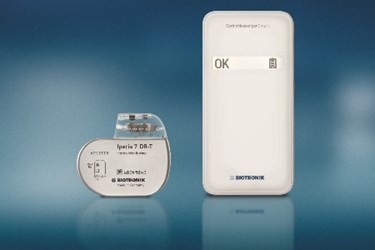CardioMessenger Smart With BIOTRONIK Home Monitoring Enhances Safety For Cardiac Device Patients

New Patient Device Allows for Earlier Therapy Adjustments in Heart Patients with Pacemakers, ICDs, CRT and BioMonitor Devices
BIOTRONIK, a leading manufacturer of cardiovascular medical technology, recently announced the CE approval of CardioMessenger Smart. The device, about the size of a smartphone, keeps pacemaker and implantable cardioverterdefibrillator (ICD) wearers connected to their physician enabling safer, more efficient treatment anywhere in the world.
CardioMessenger Smart provides fully automatic transmission of vital information from a patient’s cardiac implant to their physician via BIOTRONIK Home Monitoring. This includes information about the patient’s health condition and technical information about their device. As demonstrated by the studies TRUST1 , COMPAS2 and IN-TIME3 , Home Monitoring significantly reduces hospitalization, stroke and mortality
“Home Monitoring alerts me to relevant changes in patient or device status, ensuring that I always see the right patient at the right time,” stated Dr. Volker Leonhardt, director of telemedicine at Pacemaker and ICD Center (HIZ), Berlin. “I can keep track of each patient without subjecting him to needlessly intrusive in-person follow-ups and react quickly when necessary. This has clear clinical advantages for the patient, especially for heart failure patients, who according to the IN-TIME study benefit from a mortality reduction of more than 50 percent.”
CardioMessenger Smart sends information from the device to the BIOTRONIK Home Monitoring Service Center over the Global System for Mobile Communication (GSM) cellular network using wireless RF’2 telemetry and coded data transmission for maximum safety and security. Consistent and reliable data transmission occurs both daily and when triggered by an event. A call back message for patients enables physicians to get in contact with their patients whenever necessary.
Furthermore, the CardioMessenger Smart is easy to set up. To enable daily, automatic wireless transmission of device data via the GSM cellular network, the patient simply needs to connect the device to a power source. It then automatically transmits to the Home Monitoring Service Center from anywhere in the world. Since the CardioMessenger Smart does not require connection to a landline, patients benefit from improved safety and greater peace of mind, whether at home or abroad. Additionally, its small and modern design fits inconspicuously into every home environment, without any disturbing sounds or lights.
“Recent years have seen a shift towards early detection and prevention. By helping healthcare providers better manage their patients, Home Monitoring improves the efficacy and safety of cardiac rhythm therapy,” commented Wolf Ruhnke, Vice President of BIOTRONIK. “Patient-centric advanced technologies like Home Monitoring allow implant patients to go about their lives with the peace of mind that comes from knowing they are taken care of, anywhere, anytime.”
About BIOTRONIK
One of the world’s leading manufacturers of cardio- and endovascular medical devices, BIOTRONIK is headquartered in Berlin, Germany, and represented in over 100 countries by its global workforce of more than 5,600 employees. Several million patients have received BIOTRONIK implants designed to save and improve the quality of their lives, or have been treated with BIOTRONIK coronary and peripheral vascular intervention products. Since its development of the first German pacemaker in 1963, BIOTRONIK has engineered many innovations, including BIOTRONIK Home Monitoring; the world’s first 4 F-compatible 200 mm peripheral stent; Orsiro, the industry’s first hybrid drug-eluting stent; and the world’s first implantable cardioverter-defibrillators and heart failure therapy devices with ProMRI technology. For more information, visit www.biotronik.com.
1 Varma V et al. Circulation. 2010, 122(4).
2 Mabo P et al. European Heart Journal. 2012, 33.
3 Hindricks G et al. The Lancet. 2014, 384(9943).
Source: BIOTRONIK
